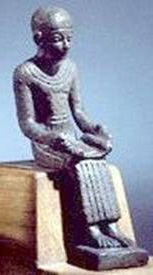
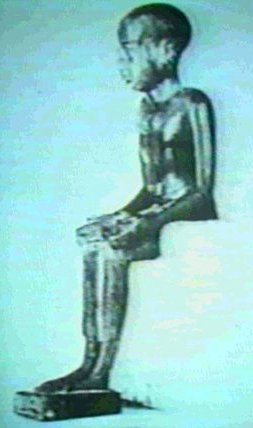
One human being of the ancient world who left a profound impact on history was the world's first documented multi-genius Imhotep, which means “he who comes in peace.” Imhotep held many titles such as sage, scribe, poet, chief lector priest, architect, astronomer, magician, chief physician to the king, and second in command of Kemet (Egypt).
Imhotep received accolades for his literary mastery that earned him recognition in modern times as; "the first man of science in recorded history," "the real Father of Medicine and healing," and "the world's first doctor". Sir William Osier also commented that, "The first figure of a Physician to stand out clearly from the mists of antiquity".
Imhotep lived in Kemet – Egypt at the court of King Zoser (Djoser) of the 3rd Dynasty around 2,980 B.C. and designed Kemet’s first pyramid. He established such a reputation as a physician and healer, that during the later stages his adoration grew into deification where he was worshipped as a god for the next 3,000 years in Egypt, Greece and Rome.
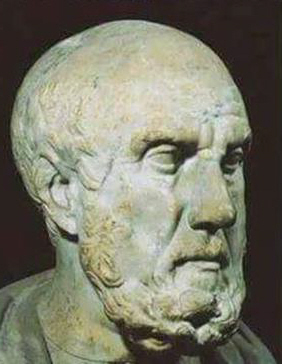
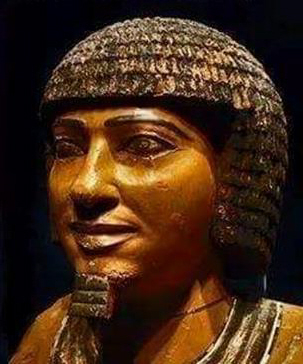 Imhotep, as a physician, was acknowledged as the author of the Edwin Smith Papyrus which describes more than 90 anatomical terms and 48 injuries. In Memphis, Imhotep also founded a school of medicine known as Asklepion that remained famous for two thousand years. This took place well over "2,000 years before the Western Father of Medicine Hippocrates was even born". A medical document that he authored is still studied to this day by medical students around the globe. In the area of medicine therefore, Hippocrates, who was born around 460 B.C., (left) is regarded as the “father of medicine”, whereas Imhotep, (right) who was born around 2,700 B.C., was worshipped as the “God of medicine.”
Imhotep, as a physician, was acknowledged as the author of the Edwin Smith Papyrus which describes more than 90 anatomical terms and 48 injuries. In Memphis, Imhotep also founded a school of medicine known as Asklepion that remained famous for two thousand years. This took place well over "2,000 years before the Western Father of Medicine Hippocrates was even born". A medical document that he authored is still studied to this day by medical students around the globe. In the area of medicine therefore, Hippocrates, who was born around 460 B.C., (left) is regarded as the “father of medicine”, whereas Imhotep, (right) who was born around 2,700 B.C., was worshipped as the “God of medicine.”
Imhotep, who also performed surgery and dentistry, diagnosed and treated over 200 diseases with some related to the abdomen, bladder, rectum, eyes, skin, hair, nails and tongue. He extracted medicine from plants and cured such diseases as spinal tuberculosis, gallstones, appendicitis, gout, mastoid diseases, rheumatoid and arthritis.
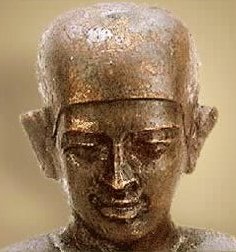 Imhotep and the native Black Egyptians were skilled at detecting diseases by observing the shape, colour or condition of the visible areas of the body like the skin, hair, nails and tongue. They also possessed knowledge of the position and functions of the stomach, lungs, and other vital organs. Furthermore, Imhotep was familiar with the circulation of the blood system some 4,000 years before it was identified in Europe, since Egyptian civilization had lasted for 6,000 years and would have allowed its greatest thinkers and scientists to effectively carry out major research to an advanced level in many areas.
Imhotep and the native Black Egyptians were skilled at detecting diseases by observing the shape, colour or condition of the visible areas of the body like the skin, hair, nails and tongue. They also possessed knowledge of the position and functions of the stomach, lungs, and other vital organs. Furthermore, Imhotep was familiar with the circulation of the blood system some 4,000 years before it was identified in Europe, since Egyptian civilization had lasted for 6,000 years and would have allowed its greatest thinkers and scientists to effectively carry out major research to an advanced level in many areas.
The Per-Ankh was the world’s first hospital known as The House of Life which has evolved into today’s hospital. On the walls are carved many of the medical instruments which still carry the exact dimensions, styles and shapes still used in medical operating theatres today.
 Carved on the wall is an ancient prescription that Imhotep gave to patients on whom he performed surgery or medical work, and the bowl used to cleanse his hands.
Carved on the wall is an ancient prescription that Imhotep gave to patients on whom he performed surgery or medical work, and the bowl used to cleanse his hands.
But what is striking about this Per-Ankh is that it shows medical instruments in this sacred temple dating back to over 3,000 years to which modern day doctors can still easily identify. This is a stethoscope carved into stone in the house of life.
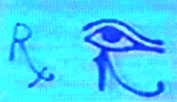
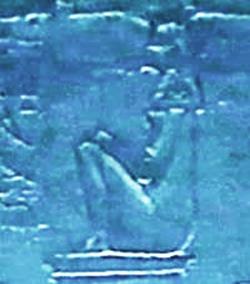 On the left is the pharmaceutical RX symbol which is carved on the temple walls which evolved out of The eye of Heru (Horus).
On the left is the pharmaceutical RX symbol which is carved on the temple walls which evolved out of The eye of Heru (Horus).
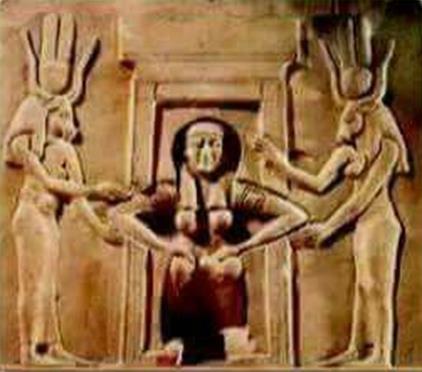 On the right is a birthing chair displayed in this carving on which Aset is sitting, showing the proper way for a woman to give birth.
On the right is a birthing chair displayed in this carving on which Aset is sitting, showing the proper way for a woman to give birth.
This Kemetic (Egyptian) wall painting (left) also portrays a pregnant woman giving birth in the squatting position, which is far more natural for the woman’s body as opposed to lying flat on the back as is currently done.
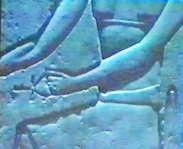 Note in this left image that the head of Imhotep has been completely severed. This continues to highlight the type of defacement and denial of who this great Black multi-genius was who lived 5,000 years ago, knowing that it is still being erroneously taught in schools today, that Michelangelo was the first multi-genius.
Note in this left image that the head of Imhotep has been completely severed. This continues to highlight the type of defacement and denial of who this great Black multi-genius was who lived 5,000 years ago, knowing that it is still being erroneously taught in schools today, that Michelangelo was the first multi-genius.

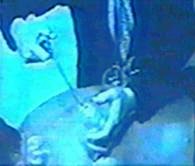 Also carved on the sacred walls are suction cups that were used to suck out diseases some 3,000 years ago, a product which is also still in use today.
Normally, when Europeans visit the temple walls, no one points out these facts to them because of the system of white supremacy, where the European continues to promote the myth that the whole world was civilized by white people, therefore this type of correct information would obviously destroy their false feeling of superiority.
Also carved on the sacred walls are suction cups that were used to suck out diseases some 3,000 years ago, a product which is also still in use today.
Normally, when Europeans visit the temple walls, no one points out these facts to them because of the system of white supremacy, where the European continues to promote the myth that the whole world was civilized by white people, therefore this type of correct information would obviously destroy their false feeling of superiority.
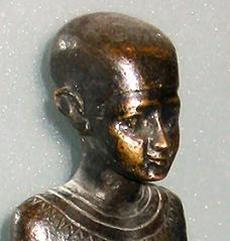 As Imhotep's fame increased after his death, he was worshipped as a medical demi-god from 2,850 B.C. to 525 B.C. before being elevated to full deity in 525 B.C., thereby replacing Nefertum in the great trinity at Memphis (Nefertum, Sekhmet his mother and Ptah his father). Kings and queens bowed at his shrine.
As Imhotep's fame increased after his death, he was worshipped as a medical demi-god from 2,850 B.C. to 525 B.C. before being elevated to full deity in 525 B.C., thereby replacing Nefertum in the great trinity at Memphis (Nefertum, Sekhmet his mother and Ptah his father). Kings and queens bowed at his shrine.
Imhotep was identified as the Son of Ptah, Father of the Gods in the Turin Canon, - (an ancient Egyptian manuscript in the Egyptian Museum of Turin, Italy, written during the 19th dynasty which chronologically lists the Egyptian kings from ancient times to Rameses II). He was addressed in glowing terms of supplication such as, "turn thy face towards me, My Lord Imhotep, Son of Ptah. It is thou who dost work miracles and who are beneficent in all thy deeds".
After Egyptian civilization made its way into the Mediterranean and became the foundation of Greek culture, the teachings of Imhotep and his accomplishments in Egypt spread to Greece where they were also adopted. Imhotep was introduced to the City of Memphis and embraced in the name of love as a son of Apollo, (the Greek God of the Sun), where he became the God of medicine to the Greeks. Imhotep (called Imouthes) was worshipped by the Greeks and identified with their mythological god of medicine, Asklepios. The Greeks even erected a temple to honour him called To Æsculapius (Imhotep's Greek god name) near the Serapeum at Memphis 2,500 years after his death.
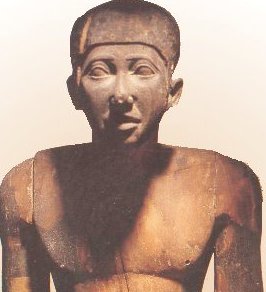 Imhotep became so renowned that he was also honoured by the Romans. For example, the emperors Claudius and Tiberius had inscriptions inscribed on the walls of their Egyptian temples that praised him. At Saqqara where his tomb is believed to be located, people brought offerings, including mummified Ibises, (domesticated birds in Egypt), and clay replicas of diseased limbs and organs, firmly believing that they would be cured. Even the early Christians worshipped him as the Prince of Peace and one with Christ. His fame survived until the Arab invasion of North Afrika during the 7th century A.D.
Imhotep became so renowned that he was also honoured by the Romans. For example, the emperors Claudius and Tiberius had inscriptions inscribed on the walls of their Egyptian temples that praised him. At Saqqara where his tomb is believed to be located, people brought offerings, including mummified Ibises, (domesticated birds in Egypt), and clay replicas of diseased limbs and organs, firmly believing that they would be cured. Even the early Christians worshipped him as the Prince of Peace and one with Christ. His fame survived until the Arab invasion of North Afrika during the 7th century A.D.
The Encyclopedia Britannica says, "The evidence afforded by Egyptian and Greek texts support the view that Imhotep's reputation was respected in very early times. His prestige increased with the lapse of centuries and his temples in Greek times were the centres of medical teaching".
In reference to medicine, Homer said in The Odyssey, "In Egypt the men are more skilled in medicine than any of human kind".
The Greeks sent their young men to be educated in Egypt in much the same way that students from Egypt now go to Europe at present. But since the Greeks usually claimed that they were the architects of everything, the knowledge of Imhotep had to be deliberately suppressed and hidden from the public for thousands of years, while Hippocrates who lived 2,000 years after him, was promoted as the Father of Medicine.
Presently, every museum possesses a bronze statue of the glorified wise man, proverb-maker, physician, and architect of Zoser. Imhotep is just one example out of Black Egypt where a learned sage or venerated person could be deified after death and become a special intercessor for the living, similar to the "saints" of Roman Catholicism today.
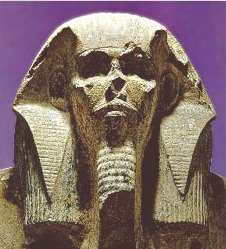 Aesclepius (Æsculapius) is internationally recognized today as the patron of physicians, and referred to in alchemical, metaphysical, and everyday medical texts as the man who knew how to revive the dying and recently dead by using the blood or venom of a snake. As primitive medicine-men were connected with snake spirits, Aesclepius was usually cited in connection with the Serpent of Epidaurus, his professional emblem, and the Cabir Telesphoros who is said to have dictated and inspired his medical prescriptions. This symbolic relationship connecting physicians, divine inspiration, and snakes survives today as a universal symbol of knowledge and wisdom in the practice of medicine.
Aesclepius (Æsculapius) is internationally recognized today as the patron of physicians, and referred to in alchemical, metaphysical, and everyday medical texts as the man who knew how to revive the dying and recently dead by using the blood or venom of a snake. As primitive medicine-men were connected with snake spirits, Aesclepius was usually cited in connection with the Serpent of Epidaurus, his professional emblem, and the Cabir Telesphoros who is said to have dictated and inspired his medical prescriptions. This symbolic relationship connecting physicians, divine inspiration, and snakes survives today as a universal symbol of knowledge and wisdom in the practice of medicine.
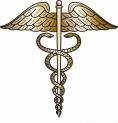 The serpent-staff symbol with its long history of being linked to religious and occult miracles appeared in Ancient Egyptian times during the rivalry between the biblical Staff of Aaron the Hebrew, and the Uraeus Staff of the Priest of the Egyptian Pharaoh. This same serpent-staff model has been adopted by the American Medical Association in their development of the Caduceus symbol, which resembles a winged flagpole with two entwined serpents. For example, every doctor whether Black or white takes The Hippocratic Oath which says, "I swear by Apollo the physician, by Æsculapius, Hygeia, and Panacea, and I take to witness all the gods, all the goddesses, to keep according to my ability and my judgement, the following Oath..."
The serpent-staff symbol with its long history of being linked to religious and occult miracles appeared in Ancient Egyptian times during the rivalry between the biblical Staff of Aaron the Hebrew, and the Uraeus Staff of the Priest of the Egyptian Pharaoh. This same serpent-staff model has been adopted by the American Medical Association in their development of the Caduceus symbol, which resembles a winged flagpole with two entwined serpents. For example, every doctor whether Black or white takes The Hippocratic Oath which says, "I swear by Apollo the physician, by Æsculapius, Hygeia, and Panacea, and I take to witness all the gods, all the goddesses, to keep according to my ability and my judgement, the following Oath..."
Æsculapius is the Greek name bestowed upon the Black Afrikan, Imhotep.
Hygieia was mainly associated with the prevention of sickness and the continuation of good health. She was a daughter of Asclepius and goddess of health, cleanliness and sanitation, who also played a vital part in her father's cult. Though she was the subject of a local cult since the 7th century B.C., it did not gather momentum until after the Oracle at Delphi recognized her, and after the plague which devastated Athens in 429 and 427 B.C., and Rome in 293 B.C.
A panacea is a cure-all, either physical medication or a solution to a problem prepared to prolong life.



AFRIKAN MEDICINE



Afrikans or Black people are hardly ever given credit in standard textbooks, nonetheless, Afrikan wisdom contributed tremendously towards the development of modern day medicine. For example, in Western Afrika during the Songhai Empire when Europe was still in the Dark Ages around 1,457 AD, the city of Jeanne had a medical school which employed hundreds of teachers and was well-known internationally for training surgeons in difficult operations like cataract surgery. They taught the pharmacological use of over one thousand animal and plant products for the treatment of medical illnesses. Many of these same medicines in liquid or pill forms are still used today like castor oil and castor seeds which were used for constipation. Kaolin, used for diarrhoea, is still used today in kaopectate, and Ox liver, rich in vitamin "A" was used to treat night blindness caused by a deficiency of vitamin "A". Onions, which have a high vitamin C content, were used to treat Vitamin "C" deficiency.
The ancient Egyptians far exceeded the rest of the ancient world in medical knowledge, and knew much about antibiotic penicillin and its therapeutic properties. The presence of the antibiotic tetracycline appeared only in the bones of farmers from northern Sudan about 1,500 years ago, where it was discovered that streptomyces moulds easily produce tetracycline on stored grain and purposefully used tetracycline to treat infections. No evidence exists to indicate that the tetracycline antibiotic, which was not rediscovered until the twentieth century, has been used anywhere else in the world.
 About half of the modern pharmacological medicines are derived from traditional Afrikan medicinal herbs. The Yoruba of Nigeria used the plant Rauwolfia vomitoria as a sedative to calm agitated or psychotic patients, and modern medicine has been able to isolate a substance called reserpine which can also lower blood pressure from this same plant.
About half of the modern pharmacological medicines are derived from traditional Afrikan medicinal herbs. The Yoruba of Nigeria used the plant Rauwolfia vomitoria as a sedative to calm agitated or psychotic patients, and modern medicine has been able to isolate a substance called reserpine which can also lower blood pressure from this same plant.
Around 1721 in America, Onesimus, an Afrikan slave taught his master an age old Afrikan technique used to inoculate smallpox, where a pustule from an infected person was broken with a thorn and then used to puncture the skin of a healthy person. Subsequently, during a smallpox epidemic in the Boston, MA area, 241 healthy people were inoculated using this Afrikan technique, and only six contracted smallpox.
During the American Revolutionary War, George Washington had inoculated his entire army against smallpox using this Afrikan procedure which was only modified in the 1790's by Dr. Edward Jenner, who altered the Afrikan smallpox inoculation technique simply by using a less hazardous type of smallpox germ.
In Europe, as recently as 1880 AD, the mortality rate was about one hundred percent for mothers delivering babies by caesarean section, a technique that was only used to save the life of the infant. However, Dr. R. W. Felkin shocked the European medical community when in the Edinburgh Medical Journal of 1884, he published that the Banyoro surgeons in Uganda routinely performed caesarean sections without any harmful effects to the mother or the child.
A group of European surgeons then went to study in Uganda for six months before successfully learning the advanced surgical techniques that were common place for the Afrikans. The European surgeons were also taught sophisticated concepts of anaesthesia and antisepsis such as the routine washing of their hands and the mother's abdomen with alcohol prior to surgery, to prevent infection.
This antisepsis technique had not been practiced in Europe prior to this Afrikan visit.
Clearly Imhotep and the Black Afrikans have contributed greatly to the development of modern medicine and ought to be better recognised in modern day medical textbooks.

© John Moore - Barbados, W.I. (March 2000) ©. All rights reserved.